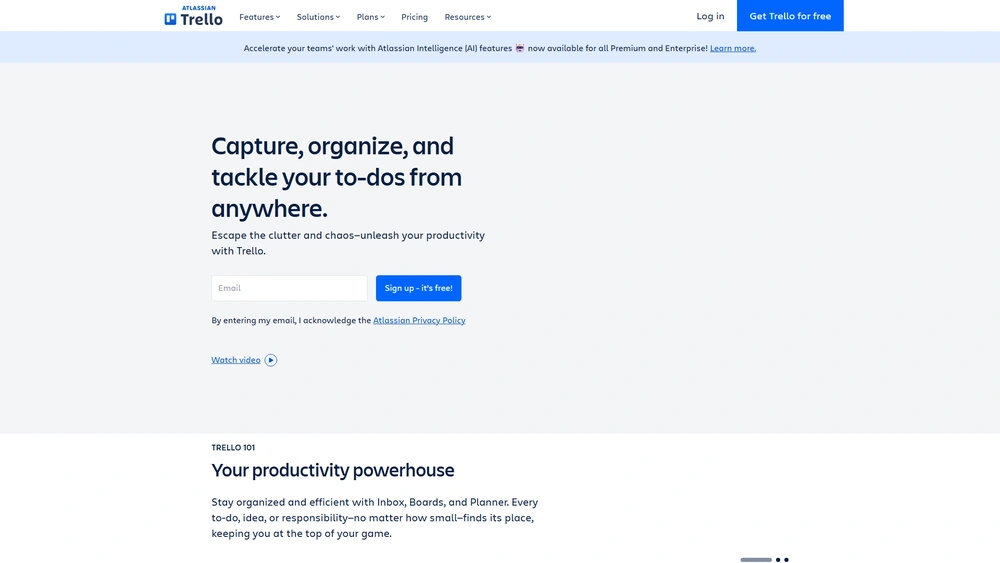Trello Overview & 2025 Industry Position
In the dynamic world of productivity tools, Trello has secured a lasting position thanks to its simple, yet powerful approach to task management. Introduced as a visual whiteboard for project collaboration, Trello evolved into a flexible system that serves individuals, startups, and enterprise-level teams alike. By mid-2025, Trello continues to thrive in a competitive field with its Kanban-style user interface, robust integration ecosystem, and automation features. It’s especially valued for its visual simplicity, ideal for remote teams and agile workflows. With Atlassian’s continued backing, Trello in 2025 leans heavily into role-based layouts, AI-driven card suggestions, and deeper integrations with Atlassian’s ecosystem for even smarter project orchestration.
From Launch to 2025: Trello’s Journey
Trello launched in 2011 as a side project at Fog Creek Software. Recognized for disrupting traditional task lists with a card/board structure, it quickly gained traction across industries. Atlassian acquired Trello in 2017, integrating it into its software suite. Noteworthy milestones include:
- 2011 – Trello’s public beta release
- 2014 – Surpassed 5M users
- 2017 – Acquired by Atlassian
- 2019 – Launched Butler automation
- 2023 – Introduced smart templates & Workspaces 2.0
- 2025 – Rolled out AI-powered Smart Boards
In 2025, Trello’s strategic thesis focuses on delivering unified team visibility through context-driven boards that automate decision making and cross-tool syncing.

Trello Key Features
Trello shines because of its highly intuitive interface and modular feature stack. In 2025, Trello’s standout functionalities include:
- Smart Boards: Auto-suggestions backed by AI to prioritize and delegate tasks
- Butler Automation: Rule-based workflows for recurring actions
- Templates Library: Industry-specific board templates updated quarterly
- Views: Switch between standard Kanban, timeline, calendar, and dashboard views
- Workspaces 2.0: Team-level coordination with role-based card assignments
- Power-Ups: Over 200 integrations and add-ons
Workflow & UX
Trello’s strength lies in its user-first design. Cards can represent tasks, goals, or documents, and are easily moved across columns representing stages of a process. Teams benefit from:
- Drag-and-drop interface: Visually intuitive and fast to learn
- Mobile-first experience: Responsive apps for iOS and Android
- Quick Add: Keyboard shortcuts and voice-input options
- Real-time sync: Instant updates across users and devices
New in 2025: AI-powered card descriptions, which summarize task inputs to reduce manual typing and miscommunication.
Trello Pricing Analysis & Value Metrics
| Plan | Monthly Price | Key Inclusions |
|---|---|---|
| Free | $0 | Up to 10 boards, unlimited cards, basic Power-Ups |
| Standard | $6/user | Unlimited boards, advanced checklists, custom fields |
| Premium | $12/user | Timeline/calendar/map views, admin permissions, priority support |
| Enterprise | $17.50/user (100-user min) | Advanced admin/permissions, SSO, DLP compliance |
At every tier, Trello delivers strong ROI. The Premium and Enterprise plans, in particular, offer excellent value to teams scaling coordination across departments.
Competitive Landscape
| Tool | Key Strength | Starting Price | Ideal Users |
|---|---|---|---|
| ClickUp | All-in-one productivity with docs/tasks/chat | $7/user | Startups and creative agencies |
| Asana | Workflows with goal tracking | $10.99/user | Mid-to-large businesses |
| Notion | Minimalist wiki-style workflows | $8/user | Writers, startups, solo devs |
| Trello Standard | Visual simplicity + API-rich Power-Ups | $6/user | Visual thinkers & remote teams |
Top Integrations
Power-Ups make Trello’s modularity shine. Popular 2025 integrations include:
- Slack: Receive board notifications in chat
- Zapier: Connect Trello boards to over 2,000 services
- Google Drive: Attach, preview, and comment on files
- Jira: Sync Trello with development sprints
- Salesforce: Surface Trello inside CRM pipelines
Pro Tip: Use Trello’s calendar view with due date alerts to double efficiency on deadline-driven tasks.
Pros & Cons
- Pros:
- Simple, drag-and-drop card system
- Generous free plan with many integrations
- Great for external collaboration and visibility
- AI assistance for task suggestions
- Cons:
- Board clutter becomes an issue in larger teams
- No built-in messaging/chat compared to rivals
- Gantt chart limitations unless on Premium+
Use Cases
The versatility of Trello makes it ideal across many verticals in 2025. Notable use cases include:
- Startups: Organize sprint planning and fundraising boards
- Agencies: Track client requests and content calendar flows
- Teachers: Map out lesson plans and student projects
- Remote Teams: Align goals, blockers, and updates visually
- Operations Teams: Cross-department process tracking
Final Thoughts
Trello remains a standout option in 2025 for frontline teams and managers who crave simplicity without compromising on power. Whether you’re an educator digitizing workflows or a VP aligning team tasks globally, Trello’s adaptive nature and deep integrations make it a trustworthy partner in productivity. Just know that larger tech-forward organizations might outgrow it unless augmented with additional Atlassian tools.
Trello FAQ
Yes, Trello offers a robust Free plan ideal for individuals or freelance use, supporting up to 10 boards and unlimited cards.
Yes. Trello integrates directly with Jira, allowing cross-syncing between task boards and development sprints, especially useful for Agile teams.
Trello’s desktop and mobile apps support offline mode. Changes sync automatically once a connection is reestablished.
Power-Ups are Trello’s term for native and third-party integrations. They extend board functionality across tools like Google Drive, Slack, and Zapier.
Yes. Trello Workspaces let different teams operate in distinct contexts with custom permissions, helping larger orgs stay organized.